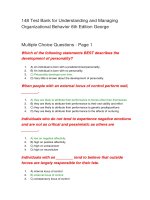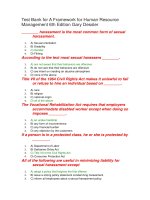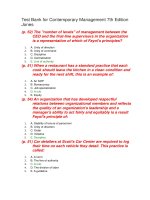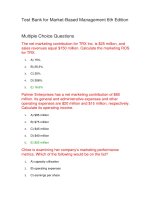contemporary management 6th jones george
Bạn đang xem bản rút gọn của tài liệu. Xem và tải ngay bản đầy đủ của tài liệu tại đây (23.31 MB, 588 trang )
LEARNSMART ADVANTAGE WORKS
A
B
C
D
30.5%
33.5%
22.6%
8.7%
More C students
4.7%
A
B
C
D
19.3%
38.6%
28.0%
9.6%
earn B’s
*Study: 690 students / 6 institutions
4.5%
Without LearnSmart
Over 20%
more students
pass the class
with LearnSmart
Pass Rate - 70%
*A&P Research Study
Without LearnSmart Pass Rate - 57%
100% –
More than 60%
– Extremely
80% –
of all students agreed
LearnSmart was a
very or extremely
helpful learning tool
– Very
60% –
40% –
– Moderately
20% –
Jan - Dec 2011
Jan - Mar 2012
Jan–Dec 2011
Jan–Mar 2012
0 –
– Slightly
– Not at all
*Based on 750,000 student survey responses
/>
> AVAILABLE
ON-THE-GO
/>
How do you rank against your peers?
What you know (green) and
what you still need to review
(yellow), based on your answers.
Let’s see how confident
you are on the questions.
COMPARE AND CHOOSE WHAT’S RIGHT FOR YOU
BOOK
LEARNSMART
ASSIGNMENTS
Looseleaf
LearnSmart, assignments, and
SmartBook—all in one digital
product for maximum savings!
Pop the pages into your own
binder or carry just the pages
you need.
The #1 Student Choice!
Bound Book
Access Code
Access Code
eBook
The first and only book that
adapts to you!
The smartest way to get from
a B to an A.
Save some green and some trees!
Check with your instructor about a
custom option for your course.
> Buy directly from the source at www.ShopMcGraw-Hill.com.
Essentials of
Contemporary
Management
Sixth Edition
Gareth R. Jones
Jennifer M. George
Rice University
ESSENTIALS OF CONTEMPORARY MANAGEMENT, SIXTH EDITION
Published by McGraw-Hill Education, 2 Penn Plaza, New York, NY 10121. Copyright © 2015 by McGrawHill Education. All rights reserved. Printed in the United States of America. Previous editions © 2013,
2011, and 2009. No part of this publication may be reproduced or distributed in any form or by any
means, or stored in a database or retrieval system, without the prior written consent of McGraw-Hill
Education, including, but not limited to, in any network or other electronic storage or transmission, or
broadcast for distance learning.
Some ancillaries, including electronic and print components, may not be available to customers outside the United States.
This book is printed on acid-free paper.
1 2 3 4 5 6 7 8 9 0 DOW/DOW 1 0 9 8 7 6 5 4
ISBN 978-0-07-786253-4
MHID 0-07-786253-8
Senior Vice President, Products & Markets: Kurt L. Strand
Vice President, Content Production & Technology Services: Kimberly Meriwether David
Managing Director: Paul Ducham
Executive Brand Manager: Michael Ablassmeir
Executive Director of Development: Ann Torbert
Senior Development Editor: Trina Hauger
Marketing Manager : Elizabeth Trepkowski
Director, Content Production: Terri Schiesl
Content Project Manager: Harvey Yep
Senior Buyer: Michael R. McCormick
Design: Matt Diamond
Cover Image: Veer Images
Lead Content Licensing Specialist: Keri Johnson
Typeface: 10.5/12 Baskerville
Compositor: Laserwords Private Limited
Printer: R. R. Donnelley
All credits appearing on page or at the end of the book are considered to be an extension of the
copyright page.
Library of Congress Cataloging-in-Publication Data
Jones, Gareth R.
Essentials of contemporary management/Gareth R. Jones, Jennifer M. George.—Sixth edition.
pages cm
Includes index.
ISBN 978-0-07-786253-4 (alk. paper)—ISBN 0-07-786253-8 (alk. paper)
1. Management. I. George, Jennifer M. II. Title.
HD31.J5974 2015
658--dc23
2013042410
The Internet addresses listed in the text were accurate at the time of publication. The inclusion of a
website does not indicate an endorsement by the authors or McGraw-Hill Education, and McGraw-Hill
Education does not guarantee the accuracy of the information presented at these sites.
www.mhhe.com
Brief Contents
Part One
Part Five
Management and Managers
Leading Individuals and Groups
Chapter One
Chapter Nine
The Management Process Today
Appendix A: History of Management Thought
2
36
Motivation
Chapter Ten
Chapter Two
Leaders and Leadership
Values, Attitudes, Emotions, and Culture:
The Manager as a Person
44
Chapter Eleven
Part Two
Chapter Twelve
The Environment of Management
Building and Managing Human
Resources
Chapter Three
Managing Ethics and Diversity
78
Chapter Four
Managing in the Global Environment
118
Part Three
Decision Making, Learning, Creativity, and
Entrepreneurship
154
Chapter Six
356
386
Part Six
Controlling Essential Activities
and Processes
Chapter Thirteen
Operations Management:
Managing Vital Operations
and Processes
Appendix B: Career Development
184
Part Four
Organizing and Change
Chapter Seven
Designing Organizational Structure
326
420
Chapter Fourteen
Chapter Five
Planning, Strategy, and Competitive
Advantage
Effective Team Management
Communication and Information
Technology Management
Planning, Decision Making, and
Competitive Advantage
296
222
Glossary
Notes
Photo Credits
Name Index
Subject Index
Company Index
454
480
485
495
525
526
534
543
Chapter Eight
Control, Change, and
Entrepreneurship
258
v
Contents
Part One Management and Managers
Chapter One
The Management Process Today
2
Overview
Management Snapshot
Tim Cook Succeeds Steve Jobs
as CEO of Apple 3
What Is Management?
Achieving High Performance:
A Manager’s Goal
5
Why Study Management?
6
Essential Managerial Tasks
Planning
Manager as a Person: Joe
Coulombe Knows How to Make
an Organization Work
Organizing
Leading
Controlling
Chapter Two
5
7
8
10
11
11
12
Levels and Skills
of Managers
Levels of Management
Managerial Skills
Recent Changes in
Management Practices
13
13
15
18
Restructuring and
Outsourcing
18
Managing Globally: First
Outsourcing, Now Insourcing
20
Empowerment and
Self-Managed Teams
Values, Attitudes, Emotions, and Culture: The
Manager as a Person
21
44
Overview
Management Snapshot
Kevin Plank’s Determination at
Under Armour 45
Enduring Characteristics:
Personality Traits
47
The Big Five Personality
Traits
47
Other Personality Traits That
Affect Managerial Behavior
51
Values, Attitudes, and Moods
52
and Emotions
Values: Terminal and
Instrumental
Attitudes
vi
53
54
Ethics in Action: Protecting
the Environment and Jobs at
Subaru of Indiana Automotive
56
Moods and Emotions
60
Management Insight:
Emotions as Triggers for
Changes in Organizations
61
Management in Action
Challenges for Management
in a Global Environment 22
Building Competitive
Advantage
Maintaining Ethical and
Socially Responsible
Standards
Ethics in Action: “What Goes
Around Comes Around”: How
Dishonest Top Managers Can
Corrupt Any Organization—Even
a Court
23
25
26
Managing a Diverse
Workforce
27
Utilizing IT and E-Commerce 28
Summary and Review
29
Management in Action
30
Topics for Discussion and Action
30
Building Management Skills:
Thinking about Managers and
Management
31
Managing Ethically
31
Small Group Breakout Exercise:
Opening a New Restaurant
31
Be the Manager: Problems at
Achieva
32
Bloomberg Businessweek Case in the News:
Costco CEO Craig Jelinek Leads the
Cheapest, Happiest Company in the
World
32
Appendix A: History of
Management Thought
F. W. Taylor and Scientific
Management
Weber’s Bureaucratic Theory
The Work of Mary Parker
Follett
The Hawthorne Studies and
Human Relations
Theory X and Theory Y
36
36
38
40
40
42
Management in Action
Emotional Intelligence
63
Summary and Review
Organizational Culture
63
Management in Action
73
Topics for Discussion and Action
Building Management Skills:
Diagnosing Culture
Managing Ethically
73
Managers and Organizational
Culture
65
The Role of Values and Norms
in Organizational Culture
67
Culture and Managerial
Action
71
73
74
74
Small Group Breakout Exercise: Making
Difficult Decisions in Hard Times
75
Be the Manager
75
The Wall Street Journal Case
in the News: More Action,
Less Drama at Disney
75
vii
Contents
Part Two The Environment of Management
Chapter Three
Managing Ethics and Diversity
78
Overview
Management Snapshot
Whole Foods Market
Practices What It Preaches 79
The Nature of Ethics
80
Ethical Dilemmas
81
Ethics and the Law
81
Changes in Ethics over Time 82
Stakeholders and Ethics
83
Stockholders
84
Managers
85
Employees
87
Suppliers and Distributors
87
Customers
87
Community, Society, and
Nation
88
Rules for Ethical Decision
Making
89
Why Should Managers Behave
Ethically?
91
Chapter Four
Sources of an Organization’s
Code of Ethics
94
Ethical Organizational
Cultures
95
The Increasing Diversity
of the Workforce and the
Environment
Age
Gender
Race and Ethnicity
Religion
Capabilities/Disabilities
Ethics in Action: Disabled
Employees Make Valuable
Contributions
Managing in the Global Environment
96
97
98
99
100
101
102
118
Overview
Management Snapshot
Nokia Flips Its Approach
to Managing the Global
Environment 119
What Is the Global
Environment?
120
The Task Environment
122
Suppliers
Managing Globally:
How Microsoft Became a
Powerful Nokia Supplier
Distributors
Customers
Competitors
The General Environment
Economic Forces
Technological Forces
viii
122
Sociocultural Forces
Demographic Forces
Political and Legal Forces
The Changing Global
Environment
131
133
133
134
The Process of Globalization 135
125
126
127
127
130
130
131
Managing Globally: IKEA
Is on Top of the Furniture World
136
Declining Barriers to Trade
and Investment
138
Declining Barriers of Distance
and Culture
139
Effects of Free Trade on
Managers
140
Management in Action
Socioeconomic Background 104
Sexual Orientation
105
Focus on Diversity:
Preventing Discrimination Based
on Sexual Orientation
105
Other Kinds of Diversity
106
Managers and the Effective
Management of Diversity 107
Critical Managerial Roles
107
Effectively Managing Diversity
Makes Good Business Sense 109
Sexual Harassment
Summary and Review
113
Management in Action
114
Topics for Discussion and Action
114
Building Management Skills:
Solving Diversity-Related Problems
114
Managing Ethically
114
Small Group Breakout Exercise:
Determining If a Problem Exists
115
Be the Manager
115
The Wall Street Journal Case in the News:
Legislators Step Up Push for Paid Sick
Leave
116
110
Forms of Sexual Harassment 111
Steps Managers Can Take to
Eradicate Sexual Harassment 111
Management in Action
The Role of National
Culture
141
Cultural Values and Norms 142
Hofstede’s Model of National
Culture
142
National Culture and Global
Management
144
Manager as a Person:
Kazuo Hirai Replaces Howard
Stringer as CEO of Sony
Summary and Review
148
Management in Action
149
Topics for Discussion and Action
Building Management Skills:
Analyzing an Organization’s
Environment
Managing Ethically:
Small Group Breakout Exercise:
How to Enter the Copying Business
149
Be the Manager: The Changing
Environment of Retailing
Bloomberg Businessweek Case
in the News: How Samsung Became
the World’s No. 1 Smartphone Maker
150
151
149
150
150
146
ix
Contents
Part Three Planning, Decision Making, and Competitive Advantage
Chapter Five
Decision Making, Learning, Creativity,
and Entrepreneurship
154
Overview
Management Snapshot
Decision Making and
Learning at GarageTek 155
The Nature of Managerial
Decision Making
Programmed and
Nonprogrammed Decision
Making
156
157
Manager as a Person: Curbing
Overconfidence
159
The Classical Model
The Administrative Model
Chapter Six
160
160
Steps in the DecisionMaking Process
Recognize the Need for a
Decision
Generate Alternatives
Assess Alternatives
Ethics in Action: Helping to
Ensure Decisions Contribute
to Sustainability
Planning, Strategy, and Competitive
Advantage
163
164
165
165
167
184
Overview
Management Snapshot
Different Ways to Compete
in the Soft Drink Business 185
Planning and Strategy
186
The Nature of the Planning
187
Process
Why Planning Is Important 187
Levels of Planning
189
Levels and Types of Planning 190
Time Horizons of Plans
191
Standing Plans and Single-Use
Plans
192
Determining the
Organization’s Mission
and Goals
Defining the Business
Establishing Major Goals
x
192
193
193
Formulating Strategy
SWOT Analysis
194
194
Manager as a Person: Douglas
Conant Keeps Campbell Soup Hot 196
The Five Forces Model
198
Formulating Business-Level
199
Strategies
Low-Cost Strategy
Differentiation Strategy
“Stuck in the Middle”
Focused Low-Cost and
Focused Differentiation
Strategies
199
200
200
201
Management in Action
Choose among Alternatives
Implement the Chosen
Alternative
Learn from Feedback
Group Decision Making
The Perils of Groupthink
Devil’s Advocacy
Diversity among Decision
Makers
168
168
168
169
169
170
170
Organizational Learning
and Creativity
170
Creating a Learning
Organization
171
Promoting Individual
Creativity
172
Promoting Group Creativity 173
Entrepreneurship and
Creativity
Entrepreneurship and New
Ventures
Intrapreneurship and
Organizational Learning
174
175
Summary and Review
177
Management in Action
178
Topics for Discussion and Action
Building Management Skills:
How Do You Make Decisions?
Managing Ethically
Small Group Breakout Exercise:
Brainstorming
Be the Manager
Fast Company Case in the News:
Working Beyond the Cube
178
179
179
180
180
181
176
Management in Action
Formulating CorporateLevel Strategies
Concentration on a Single
Industry
202
203
Management Insight: Krispy
Kreme Doughnuts Are Hot Again 203
Vertical Integration
Diversification
204
206
Management Insight: VF Corp.
Acquires Timberland to Realize
the Benefits from Related
Diversification
207
International Expansion
209
Planning and Implementing
214
Strategy
Summary and Review
215
Management in Action
215
Topics for Discussion and Action
Building Management Skills: How to
Analyze a Company’s Strategy
Managing Ethically
Small Group Breakout Exercise:
Low Cost or Differentiation?
Be the Manager
Bloomberg Businessweek Case in the
News: GM, Ford, and Chrysler: The
Detroit Three Are Back, Right?
215
216
216
217
217
217
xi
Contents
Part Four Organizing and Change
Chapter Seven
Designing Organizational Structure
222
Overview
Management Snapshot
Avon’s Global Structure
Results in a Disaster 223
Chapter Eight
Designing Organizational
Structure
The Organizational
Environment
Strategy
Technology
Human Resources
224
Management Insight: Dick’s
Drive-In Restaurants
229
224
The Job Characteristics
Model
230
225
226
227
Grouping Tasks into Jobs:
Job Design
227
Job Enlargement and Job
Enrichment
228
Grouping Jobs into
Functions and Divisions:
Designing Organizational
Structure
Functional Structure
Divisional Structures:
Product, Geographic,
and Market
Control, Change, and Entrepreneurship
232
232
234
258
Overview
Management Snapshot
How Alan Mulally
Transformed Ford 259
What Is Organizational
Control?
The Importance of
Organizational Control
Control Systems and IT
The Control Process
Management Insight: Control
Problems Arise between eBay
and Its Sellers
Output Control
Financial Measures of
Performance
xii
261
261
263
264
Management Insight: Making
the Financial Figures Come Alive
Organizational Goals
Operating Budgets
Problems with Output
Control
Behavior Control
267
269
269
Direct Supervision
Management by Objectives
Bureaucratic Control
Problems with Bureaucratic
Control
271
272
273
273
274
274
275
277
278
Management in Action
Management Insight: A School
District Moves from a Geographic
to a Market Structure
238
Summary and Review
Management in Action
253
Matrix and Product Team
Designs
Topics for Discussion and Action
Building Management Skills:
Understanding Organizing
Managing Ethically
Small Group Breakout Exercise:
Bob’s Appliances
Be the Manager: Speeding Up
Website Design
Bloomberg Businessweek Case
in the News: Microsoft’s Ballmer
Said to Plan Broad Restructuring
253
Coordinating Functions
and Divisions
239
242
Allocating Authority
242
Integrating and Coordinating
Mechanisms
247
Strategic Alliances, B2B
Network Structures,
and IT
252
253
254
254
255
256
249
Ethics in Action: Of Shoes and
Sweatshops
250
Management in Action
Organizational Culture
and Clan Control
279
Manager as a Person: UPS and
Walmart Know How to Build
Persuasive Cultures
279
Adaptive Cultures versus
Inert Cultures
281
Organizational Change
282
Assessing the Need for
Change
283
Deciding on the Change
to Make
Implementing the Change
Evaluating the Change
Entrepreneurship,
Control, and Change
Management Insight: How
Google’s Founders Created
a Groovy Culture
284
285
286
286
288
Summary and Review
289
Management in Action
290
Topics for Discussion and Action
Building Management Skills:
Understanding Controlling
Managing Ethically
Small Group Breakout Exercise:
How Best to Control the Sales Force?
Be the Manager
Bloomberg Businessweek Case
in the News: Dish Network, the
Meanest Company in America
290
291
291
291
292
292
xiii
Contents
Part Five Leading Individuals and Groups
Chapter Nine
Motivation
296
Overview
Management Snapshot
High Motivation at
Enterprise Rent-A-Car 297
The Nature of
Motivation
Managing Globally: Seeking
Intrinsic Motivation
in Far-Flung Places
Expectancy Theory
Expectancy
Instrumentality
Valence
Bringing It All Together
Need Theories
299
299
302
302
304
304
304
Equity Theory
Equity
Inequity
Ways to Restore Equity
Chapter Ten
305
Maslow’s Hierarchy of
Needs
305
Herzberg’s Motivator-Hygiene
Theory
307
McClelland’s Needs for
Achievement, Affiliation,
and Power
307
Other Needs
308
Leaders and Leadership
308
308
309
309
326
Overview
Management Snapshot
Lorenzo Effectively
Leads Frog Design 327
The Nature of
Leadership
329
Personal Leadership Style
and Managerial Tasks
329
Ethics in Action: Servant
Leadership at Zingerman’s
330
Leadership Styles across
Cultures
Power: The Key to
Leadership
332
332
Manager as a Person: Gregory
Maffei and Expert Power
334
Empowerment: An Ingredient
in Modern Management
336
xiv
Trait and Behavior Models
337
of Leadership
The Trait Model
The Behavior Model
Contingency Models of
Leadership
Fiedler’s Contingency Model
House’s Path–Goal Theory
The Leader Substitutes
Model
Bringing It All Together
337
338
339
339
341
342
343
Management in Action
Goal-Setting Theory
Learning Theories
Management Insight: Training
Spurs Learning at Stella & Dot
Operant Conditioning
Theory
Social Learning Theory
311
312
313
314
316
Pay and Motivation
Basing Merit Pay on
Individual, Group, or
Organizational
Performance
Salary Increase or Bonus?
Examples of Merit Pay
Plans
317
318
319
320
Summary and Review
321
Management in Action
322
Topics for Discussion and Action
Building Management Skills:
Diagnosing Motivation
Managing Ethically
Small Group Breakout Exercise:
Increasing Motivation
Be the Manager
The New York Times Case
in the News: Yahoo’s In-Office
Policy Aims to Bolster Morale
322
322
323
323
323
324
Management in Action
Transformational
Leadership
Being a Charismatic Leader
Stimulating Subordinates
Intellectually
Engaging in Developmental
Consideration
The Distinction between
Transformational and
Transactional Leadership
Summary and Review
344
345
346
346
347
Gender and Leadership
347
Emotional Intelligence
and Leadership
348
349
Management in Action
350
Topics for Discussion and Action
Building Management Skills:
Analyzing Failures of Leadership
Managing Ethically
Small Group Breakout Exercise:
Improving Leadership Effectiveness
Be the Manager
The Wall Street Journal Case
in the News: This CEO Used to
Have an Office
350
351
351
351
352
352
xv
Contents
Chapter Eleven
Effective Team Management
356
Overview
Management Snapshot
Using Teams to Innovate
at Boeing 357
Groups, Teams, and
Organizational
Effectiveness
Groups and Teams as
Performance Enhancers
Groups, Teams, and
Responsiveness to
Customers
Teams and Innovation
Types of Groups and
Teams
358
359
360
360
Information Technology Byte:
Pizza Teams Innovate at Amazon 361
Groups and Teams as
Motivators
Chapter Twelve
The Top Management Team
Research and Development
Teams
Command Groups
Task Forces
Self-Managed Work Teams
Management Insight:
Self-Managed Teams at Louis
Vuitton and Nucor Corporation
363
363
364
364
364
364
365
Virtual Teams
Friendship Groups
Interest Groups
368
Building and Managing Human Resources
386
362
367
368
Overview
Management Snapshot
Effectively Managing Human
Resources at Zappos 387
Strategic Human Resource
389
Management
Overview of the Components
of HRM
390
The Legal Environment
of HRM
391
Recruitment and
Selection
392
Human Resource Planning
Managing Globally: Recent
Trends in Outsourcing
xvi
393
394
Job Analysis
External and Internal
Recruitment
395
396
Information Technology Byte:
Fog Creek Software’s Approach
to Recruiting
397
The Selection Process
Training and
Development
Types of Training
Types of Development
Transfer of Training and
Development
398
402
402
403
405
Management in Action
Group Dynamics
Group Size and Roles
Group Leadership
Group Development
over Time
Group Norms
Group Cohesiveness
368
368
370
370
371
374
Managing Groups and
Teams for High
Performance
Summary and Review
377
Motivating Group Members
to Achieve Organizational
Goals
377
Reducing Social Loafing in
Groups
379
381
Management in Action
382
Topics for Discussion and Action
Building Management Skills:
Diagnosing Group Failures
Managing Ethically
Small Group Breakout Exercise:
Creating a Cross-Functional Team
Be the Manager
The Wall Street Journal Case
in the News: Tracking Sensors
Invade the Workplace
382
382
382
383
383
384
Management in Action
Performance Appraisal
and Feedback
Types of Performance
Appraisal
Who Appraises
Performance?
Effective Performance
Feedback
Pay and Benefits
410
410
405
Pay Level
Pay Structure
Benefits
407
Labor Relations
412
405
408
Unions
Collective Bargaining
410
411
412
413
Summary and Review
413
Management in Action
414
Topics for Discussion and Action
Building Management Skills:
Analyzing Human Resource
Management Systems
Managing Ethically
Small Group Breakout Exercise:
Building a Human Resource
Management System
Be the Manager
The Wall Street Journal Case
in the News: Psst . . . This Is What
Your Co-Worker Is Paid
414
415
415
415
416
416
xvii
Contents
Part Six Controlling Essential Activities and Processes
Chapter Thirteen
Communication and Information
Technology Management
420
Overview
Management Snapshot
How IT Facilitates
Communication at
Salesforce.com 421
Information and
the Manager’s Job
428
Attributes of Useful
Information
What Is Information
Technology?
Information and Decisions
Information and Control
426
Management Insight: Herman
Miller’s Office of the Future
427
Information and
Coordination
Information Richness and
434
Communication Media
428
Face-to-Face Communication 435
Spoken Communication
Electronically Transmitted 436
Communication,
Information, and
Management
Chapter Fourteen
423
The Importance of Good
Communication
The Communication
Process
The Dangers of Ineffective
Communication
423
425
425
Management Insight: Why
Managers Need Feedback from
Employees
430
432
432
428
Operations Management: Managing
Vital Operations and Processes
454
Overview
Management Snapshot
Zynga Develops New
Operational Strategies
in Online Social Gaming 455
Operations Management
and Competitive
Advantage
Customer Relationship
Management
457
Improving Responsiveness
458
to Customers
What Do Customers Want? 458
Designing Production Systems
to Be Responsive to
Customers
458
Management Insight: First Global
Xpress Delivers Packages Faster,
Cheaper, and Greener
459
xviii
Improving Quality
Management Insight: How
Starwood Uses Six Sigma to
Improve Hotel Performance
Improving Efficiency
460
462
463
464
Facilities Layout, Flexible
Manufacturing, and
Efficiency
465
Manager as a Person: How to
Improve Facilities Layout
467
Management in Action
Personally Addressed Written
Communication
436
Impersonal Written
Communication
438
Advances in Information
Technology
439
The Effects of Advancing IT 439
IT and the Product
Life Cycle
440
The Network of Computing
Power
442
Management Insight: Cloud
Computing, Bricks-and-Mortar,
and Mobile Container Data
Center Storage Solutions
Types of Management
Information Systems
Summary and Review
445
The Organizational Hierarchy:
The Traditional Information
System
445
Transaction-Processing
Systems
446
Operations Information
Systems
447
Decision Support Systems
447
Expert Systems and Artificial
Intelligence
448
Limitations of Information
448
Systems
449
Management in Action
450
Topics for Discussion and Action
Building Management Skills:
Diagnosing Ineffective
Communication
Managing Ethically
Small Group Breakout Exercise:
Using New Information Systems
Be the Manager: A Problem in
Communication
Bloomberg Businessweek Case
in the News: Netflix, Reed Hastings
Survive Missteps to Join Silicon
Valley’s Elite
450
450
450
451
451
452
442
Management in Action
Managing Globally: Igus’s
Factory of the Future
469
Just-in-Time Inventory and
Efficiency
470
Self-Managed Work Teams
and Efficiency
471
Process Reengineering and
Efficiency
471
Operations Management:
Some Remaining Issues
473
Ethics in Action: The Human
Cost of Improving Productivity
474
Summary and Review
474
Management in Action
475
Topics for Discussion and Action
Building Management Skills:
Managing a Production System
Managing Ethically
Small Group Breakout Exercise: How
to Compete in the Sandwich Business
Be the Manager: How to Build
Flat-Panel Displays
Bloomberg Businessweek Case
in the News: Inside Google’s
Secret Lab
475
476
476
476
477
Appendix B: Career
Development
Types of Careers
Career Stages
Effective Career Management
Glossary
Notes
Photo Credits
Name Index
Subject Index
Company Index
480
481
482
484
485
495
525
526
534
543
477
xix
This page intentionally left blank
Preface
In this sixth edition of Essentials of Contemporary
Management, we continue to focus on providing the most up-to-date account of the changes
taking place in the world of management and
management practices while maintaining our
emphasis on making our text relevant and interesting to students. And we know from feedback
from instructors and students that the text does
engage them. Our increased focus on the challenges and opportunities facing businesses large
and small and integrated timely examples bring
management issues to life for students.
The number and complexity of the strategic, organizational, and human resource challenges facing managers and all employees have
continued to increase throughout the 2000s.
In most companies, managers at all levels are
playing catch-up as they work toward meeting these challenges by implementing new
and improved management techniques and
practices. Today, relatively small differences in
performance between companies, such as in
the speed at which they bring new products or
services to market or in the ways they motivate
their employees to find ways to reduce costs or
improve performance, can combine to give a
company a significant competitive advantage.
Managers and companies that utilize proven
management techniques and practices in their
decision making and actions increase their effectiveness over time. Companies and managers
that are slower to implement new management
techniques and practices find themselves at a
growing competitive disadvantage that makes it
even more difficult to catch up. Thus, in many
industries there is a widening gap between the
most successful companies whose performance
reaches new heights and their weaker competitors, because their managers have made better
decisions about how to use company resources
in the most efficient and effective ways.
The challenges facing managers continue to
mount as changes in the global environment,
such as increasing global outsourcing and rising commodity prices, impact organizations
large and small. Moreover, the revolution in
information technology (IT) has transformed
how managers make decisions across all levels of
a company’s hierarchy and across all its functions
and global divisions. This sixth edition addresses
these emerging challenges. For example, we
extend our treatment of global outsourcing,
examine its pros and cons, and examine the new
management problems that emerge when millions of functional jobs in IT, customer service,
and manufacturing are performed in countries
overseas. Similarly, increasing globalization
means that managers must respond to major differences in the legal rules and regulations and
ethical values and norms that prevail in countries around the globe.
Other major challenges we continue to
expand on in this edition include the impact of
the steadily increasing diversity of the workforce
on companies and how this increasing diversity
makes it imperative for managers to understand
how and why people differ so that they can effectively manage and reap the performance benefits of diversity. Similarly, across all functions and
levels, managers and employees must continually
seek ways to “work smarter” and increase performance. Using new IT to improve all aspects of an
organization’s operations to enhance efficiency
and customer responsiveness is a vital part of
this process. So too is the continuing need to
innovate and improve the quality of goods and
services, and the ways they are produced, to
allow an organization to compete effectively. We
significantly revised this edition of Essentials of
Contemporary Management to address these challenges to managers and their organizations.
Major Content Changes
Once again, encouraged by the increasing
number of instructors and students who use
each new edition of our book, and based on
the reactions and suggestions of both users and
reviewers, we revised and updated our book
in many ways. However, the organization and
sequence of chapters remain the same in this
xxi
xxii
Preface
new edition. Instructors tell us that they like
the way the chapters flow, and the way they
build up a picture of management part by part,
to provide an excellent learning experience
and a comprehensive coverage of management. The way we link and integrate topics,
such as our inclusion of entrepreneurship in
Chapter 5, “Decision Making, Learning, Creativity, and Entrepreneurship,” allows students
to make connections among these important
topics. As examples of the many changes we
made, this new edition expands the coverage
of ways to encourage high motivation, creativity, and innovation in organizations and the
importance of managers’ and organizations’
taking steps to protect the natural environment
and promote sustainability. Our three-chapter
sequence on strategy, structure, and control systems to improve competitive advantage is also
updated in many ways. And, in this new edition,
throughout the chapters we offer increased
coverage of new approaches to leadership
and the design of reward systems, new uses of
advanced IT at all levels in the organization
and across all functions to improve job design
and employee motivation, and expanded coverage of the pros and cons associated with global
outsourcing.
CHAPTER-BY-CHAPTER CHANGES We made
the following specific changes to this edition.
Chapter 1
• New “Management Snapshot” on Tim Cook as
CEO of Apple.
• New “Manager as a Person” box on Joe
Coulombe of Trader Joe’s.
• New “Managing Globally” box on outsourcing
and insourcing.
• New 2013 “Bloomberg Businessweek Case in the
News.”
Chapter 2
• New “Management Snapshot” on “Kevin
Plank’s Determination at Under Armour.”
• New “Ethics in Action” on “Protecting the
Environment and Jobs at Subaru of Indiana
Automotive.”
• New discussion of how sometimes emotions can be triggers for change in
organizations.
• New “Management Insight” on “Emotions as
Triggers for Changes in Organizations.”
• Updated example of IBM.
• New 2013 “The Wall Street Journal Case in the
News.”
Chapter 3
• New “Management Snapshot” on how “Whole
Foods Market Practices What It Preaches.”
• Updated section on age.
• Updated and revised section on gender.
• Updated and revised section on race and
ethnicity.
• New “Ethics in Action” on how “Disabled
Employees Make Valuable Contributions.”
• Updated and revised section on socioeconomic background.
• Updated and revised section on sexual
orientation.
• Updated “Focus on Diversity” box on
“Preventing Discrimination Based on Sexual
Orientation.”
• Updated discussion of women’s earnings in
comparison to men’s earnings.
• Updated sexual harassment section.
• New 2013 “The Wall Street Journal Case in the
News.”
Chapter 4
• New “Management Snapshot” on Nokia and
managing the global environment.
• New “Managing Globally” box on Microsoft
and Nokia.
• New “Manager as a Person” box on Kazuo
Hirai as CEO of Sony.
• New 2013 “Bloomberg Businessweek Case in the
News.”
Preface
Chapter 5
• Updated “Management Snapshot” on “Decision
Making and Learning at Garage Tek.”
• Updated examples.
• New “Manager as a Person” on “Curbing
Overconfidence.”
• New discussion of the position of chief sustainability officer.
• New “Ethics in Action” box on “Helping to
Ensure Decisions Contribute to Sustainability.”
• New 2013 “Fast Company” Case in the News.”
Chapter 6
• New “Management Insight” box on Krispy
Kreme.
• New “Management Insight” box on VF Corp
and Timberland.
• New 2013 “Bloomberg Businessweek Case in the
News.”
Chapter 7
• New “Management Snapshot” on Avon.
• New “Management Insight” box on Dick’s
Drive-In Restaurants.
• New 2013 “Bloomberg Businessweek Case in the
News.”
xxiii
• New “Management Insight” on how “Training
Spurs Learning at Stella & Dot.”
• New discussion of how managers can recognize top performers when they are unable to
use merit pay due to tough economic times.
• Revised discussion of how advances in IT dramatically simplify the administration of piecerate pay.
• New 2013 “The New York Times Case in the News.”
Chapter 10
• New “Management Snapshot” on how
“Lorenzo Effectively Leads Frog Design.”
• New examples of women CEOs.
• Updated “Ethics in Action” box on “Servant
Leadership at Zingerman’s.”
• New discussion of how managers with expert
power need to recognize that they are not
always right.
• New “Manager as a Person” box on “Gregory
Maffei and Expert Power.”
• Updated statistics on the underrepresentation
of women in corporate officer and top-earner
positions.
• New 2013 “The Wall Street Journal Case in the
News.”
Chapter 11
Chapter 8
• New “Management Snapshot” on Alan Mulally
and Ford.
• New “Management Insight” box on eBay.
• New “Manager as a Person” box on UPS and
Walmart.
• New “Management Insight” box on Google.
• New 2013 “Bloomberg Businessweek Case in the
News.”
• New “Management Snapshot” on “Using
Teams to Innovate at Boeing.”
• New “Information Technology Byte” on how
“Pizza Teams Innovate at Amazon.”
• New “Management Insight” box on “SelfManaged Teams at Louis Vuitton and Nucor
Corporation.”
• New 2013 “The Wall Street Journal Case in the
News.”
Chapter 9
Chapter 12
• New “Management Snapshot” on “High Motivation at Enterprise Rent-A-Car.”
• New “Managing Globally” box on “Seeking
Intrinsic Motivation in Far Flung Places.”
• Updated “Management Snapshot” on “Effectively Managing Human Resources at Zappos.”
• New “Managing Globally” box on “Recent
Trends in Outsourcing.”
xxiv
Preface
• New “Information Technology Byte” on “Fog
Creek Software’s Approach to Recruiting.”
• Updated discussion of the use of background
checks by employers.
• Updated discussion of concerns about excessive CEO pay and pay comparisons between
CEOs and average workers.
• Updated statistics on union membership in
the U.S.
• New 2013 “The Wall Street Journal Case in the
News.”
Chapter 13
• New “Management Snapshot” on Salesforce.
com.
• New “Management Insight” box on cloud
computing, bricks-and-mortar, and mobile
container data center storage solutions.
• New 2013 “Bloomberg Businessweek Case in the
News.”
Chapter 14
• New “Management Snapshot” on Zynga Inc.
• New 2013 “Bloomberg Businessweek Case in the
News.”
UPDATED RESEARCH CONCEPTS Just as
we included pertinent new research concepts
in each chapter, so we were careful to eliminate outdated or marginal management concepts. As usual, our goal is to streamline our
presentation and keep the focus on recent
changes that have the most impact on managers and organizations. In today’s world of
video downloading, streaming media, and text
messaging and tweeting, less is often more—
especially when students are often burdened
by time pressures stemming from the need to
work long hours at paying jobs. New chapter
opening “Management Snapshot” cases, the
many boxed illustrations inside each chapter,
and new (2013) “Case in the News” closing
cases reinforce updated content critically but
succinctly.
We feel confident that the changes to
the sixth edition of Essentials of Contemporary
Management will stimulate and challenge students to think about their future in the world of
organizations.
Emphasis on Applied
Management
We went to great lengths to bring the manager
back into the subject matter of management.
That is, we wrote our chapters from the perspective of current or future managers to illustrate,
in a hands-on way, the problems and opportunities they face and how they can effectively meet
them. For example, in Chapter 3 we provide an
integrated treatment of ethics and diversity that
clearly explains their significance to practicing
managers. In Chapter 6, we provide an integrated
treatment of planning, strategy, and competitive
advantage, highlighting the crucial choices managers face as they go about performing the planning role. Throughout the text, we emphasize
important issues managers face and how management theory, research, and practice can help
them and their organizations be effective.
The last two chapters cover the topics of
managing information systems, technology, and
operations management, topics that tend to be
difficult to teach to new management students
in an interesting and novel way. Our chapters
provide a student-friendly, behavioral approach
to understanding the management processes
entailed in information systems and operations
management. As our reviewers noted, while most
books’ treatment of these issues is dry and quantitative, ours comes alive with its focus on how
managers can manage the people and processes
necessary to give an organization a competitive
advantage.
Flexible Organization
We designed the grouping of chapters to allow
instructors to teach the chapter material in the
order that best suits their needs. Instructors are
not tied to the planning, organizing, leading,
controlling framework, even though our presentation remains consistent with this approach.









